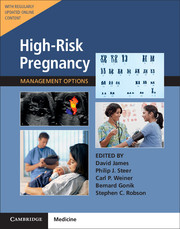Book contents
- Frontmatter
- Contents
- List of Contributors
- Preface
- Section 1 Prepregnancy Problems
- Section 2 Early Prenatal Problems
- Section 3 Late Prenatal – Fetal Problems
- 9 Prenatal Fetal Surveillance
- 10 Fetal Growth Disorders
- 11 Disorders of Amniotic Fluid
- 12 Fetal Hemolytic Disease
- 13 Fetal Thrombocytopenia
- 14 Fetal Cardiac Arrhythmias
- 15 Fetal Cardiac Abnormalities
- 16 Fetal Craniospinal and Facial Abnormalities
- 17 Fetal Genitourinary Abnormalities
- 18 Fetal Gastrointestinal and Abdominal Abnormalities
- 19 Fetal Skeletal Abnormalities
- 20 Fetal Tumors
- 21 Fetal Hydrops
- 22 Fetal Death
- Section 4 Problems Associated with Infection
- Section 5 Late Pregnancy – Maternal Problems
- Section 6 Late Prenatal – Obstetric Problems
- Section 7 Postnatal Problems
- Section 8 Normal Values
- Index
13 - Fetal Thrombocytopenia
from Section 3 - Late Prenatal – Fetal Problems
- Frontmatter
- Contents
- List of Contributors
- Preface
- Section 1 Prepregnancy Problems
- Section 2 Early Prenatal Problems
- Section 3 Late Prenatal – Fetal Problems
- 9 Prenatal Fetal Surveillance
- 10 Fetal Growth Disorders
- 11 Disorders of Amniotic Fluid
- 12 Fetal Hemolytic Disease
- 13 Fetal Thrombocytopenia
- 14 Fetal Cardiac Arrhythmias
- 15 Fetal Cardiac Abnormalities
- 16 Fetal Craniospinal and Facial Abnormalities
- 17 Fetal Genitourinary Abnormalities
- 18 Fetal Gastrointestinal and Abdominal Abnormalities
- 19 Fetal Skeletal Abnormalities
- 20 Fetal Tumors
- 21 Fetal Hydrops
- 22 Fetal Death
- Section 4 Problems Associated with Infection
- Section 5 Late Pregnancy – Maternal Problems
- Section 6 Late Prenatal – Obstetric Problems
- Section 7 Postnatal Problems
- Section 8 Normal Values
- Index
Summary
Introduction
Definition
During normal fetal life, the platelet count progressively increases, reaching a level of approximately 150 X 109/L by the end of the first trimester. Thus, healthy fetuses and neonates have platelet counts within the normal range for adults (150–450 X 109/L). Therefore, fetal and neonatal thrombocytopenia is defined as a platelet count < 150 X 109/L regardless of gestational age. For severe thrombocytopenia with a risk of bleeding problems, a cutoff of 30–50 X 109/L is commonly used. Thus, many mild to moderately thrombocytopenic neonates show no symptoms, and the disease may go unnoticed.
Severe thrombocytopenia (< 50 X 109/L) is estimated to be present in 1 in 700 unselected newborns. The underlying cause of neonatal thrombocytopenia can at least partly be predicted by the time of detection. Thrombocytopenia identified within the first 72 hours of life (early onset) is caused by conditions different from those that cause thrombocytopenia after the initial 72 hours of life (late onset).
Risks
Low fetal or neonatal platelet count is a risk factor for bleeding complications. The most serious complication is intracranial hemorrhage (ICH), which may lead to death or severe lifelong neurologic handicap.
Etiology
In general, fetal thrombocytopenia can be classified into disorders associated with:
• increased destruction of platelets
• increased consumption of platelets
• decreased production of platelets
In Table 13.1 the causes of neonatal thrombocytopenia are categorized, with severity and onset specified.
In this chapter, we will discuss the most important causes of fetal and early neonatal thrombocytopenia, with the focus on fetal and neonatal alloimmune thrombocytopenia (FNAIT), since this is the most common cause of severe thrombocytopenia, and most relevant to management in pregnancy.
Fetal and Neonatal Alloimmune Thrombocytopenia (FNAIT)
Pathophysiology and Incidence
FNAIT is caused by an immunological process in which the mother produces an antibody-mediated response against a platelet-specific antigen (human platelet antigen, HPA) that she herself lacks but that is present on the fetal platelets, inherited from the father. The fetal platelet antigens are expressed as early as 16–18 weeks of gestation. The mother's antibodies (of the immunoglobulin G [IgG] type) can cross the placenta and bind to fetal platelets. The antibody-coated platelets are subsequently removed from the fetal circulation by the reticuloendothelial system, which results in fetal thrombocytopenia.
- Type
- Chapter
- Information
- High-Risk Pregnancy: Management OptionsFive-Year Institutional Subscription with Online Updates, pp. 309 - 321Publisher: Cambridge University PressFirst published in: 2017



